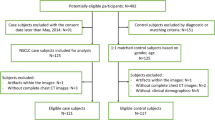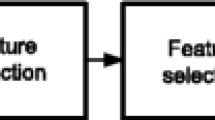Abstract
To extract texture features of pulmonary nodules from three-dimensional views and to assess if predictive models of lung CT images from a three-dimensional texture feature could improve assessments conducted by radiologists. Clinical and CT imaging data for three dimensions (axial, coronal, and sagittal) in pulmonary nodules in 285 patients were collected from multiple centers and the Cancer Imaging Archive after ethics committee approval. Three-dimensional texture feature values (contourlets), and clinical and computed tomography (CT) imaging data were built into support vector machine (SVM) models to predict lung cancer, using four evaluation methods (disjunctive, conjunctive, voting, and synthetic); sensitivity, specificity, the Youden index, discriminant power (DP), and F value were calculated to assess model effectiveness. Additionally, diagnostic accuracy (three-dimensional model, axial model, and radiologist assessment) was assessed using the area under the curves for receiver operating characteristic (ROC) curves. Cross-sectional data from 285 patients (median age, 62 [range, 45–83] years; 115 males [40.4%]) were evaluated. Integrating three-dimensional assessments, the voting method had relatively high effectiveness based on both sensitivity (0.98) and specificity (0.79), which could improve radiologist diagnosis (maximum sensitivity, 0.75; maximum specificity, 0.51) for 23% and 28% respectively. Furthermore, the three-dimensional texture feature model of the voting method has the best diagnosis of precision rate (95.4%). Of all three-dimensional texture feature methods, the result of the voting method was the best, maintaining both high sensitivity and specificity scores. Additionally, the three-dimensional texture feature models were superior to two-dimensional models and radiologist-based assessments.





Similar content being viewed by others
References
American Cancer Society: Cancer facts and figures 2015. Atlanta: American Cancer Society, 2015
Mountzios G, Dimopoulos MA, Soria JC, Sanoudou D, Papadimitriou CA: Histopathologic and genetic alterations as predictors of response to treatment and survival in lung cancer: A review of published data. Crit Rev OncolHematol 75(2):94–109, 2010
Seki N, Eguchi K, Kaneko K et al.: The adenocarcinoma-specific stage shift in the Anti-lung Cancer Association project: Significance of repeated screening for lung cancer for more than 5 years with low-dose helical computed tomography in a high-risk cohort. Lung Cancer 67(3):318–324, 2010
Wang H, Guo XH, Jia ZW, Li HK, Liang ZG, Li KC, He Q: Multilevel binomial logistic prediction model for malignant pulmonary nodules based on texture features of CT image. Eur J Radiol 74(1):124–129, 2010
Eltoukhy MM, Faye I, Samir BB: Breast cancer diagnosis in digital mammogram using multiscale curvelet transform. Comput Med Imaging and Graph 34:269–227, 2010
Guo D, Qiu T, Bian J, Kang W, Zhang L: A computer-aided diagnostic system to discriminate SPIO-enhanced magnetic resonance hepatocellular carcinoma by a neural network classifier. Comput Med Imaging and Graph 33(8):588–592, 2009
Liu YN, Wang H, Guo XH et al.: A comparison between inside and outside texture features extracting from pulmonary nodules of CT images, natural computation, 2009. ICNC '09. Fifth International Conference 6:183–186, 2009
Zhu YJ, Tan YQ, Hua YQ, Wang M, Zhang G, Zhang J: Feature selection and performance evaluation of support vector machine (SVM)-based classifier for differentiating benign and malignant pulmonary nodules by computed tomography. J Digit Imaging 23(1):51–65, 2010
Yeh C, Lin CL, Wu MT, Yen CW, Wang JF: A neural network-based diagnostic method for solitary pulmonary nodules. Neurocomputing 72:612–624, 2008
Way TW, Sahiner B, Chan HP et al.: Computer-aided diagnosis of pulmonary nodules on CT scans: Improvement of classification performance with nodule surface features. Med Phys 36(7):3086–3098, 2008
Chabat F, Yang GZ, Hansell DM et al.: Obstructive lung diseases: texture classification for differentiation at CT. Radiology 228(3):871–877, 2003
Do MN, Vetterli M: The contourlet transform: an efficient directional multiresolution image representation. IEEE Trans Image Process 14(12):2091–2106, 2005
Mohamed ME, Ibrahima F, Brahim B: A comparison of wavelet and curvelet for breast cancer diagnosis in digital mammogram. Computers in Biology and Medicine 40:384–391, 2010
Rahimi F, Rabbani H: A dual adaptive watermarking scheme in contourlet domain for DICOM images. Biomed Eng Online 10:53, 2011
Tsai NC, Chen HW, Hsu SL: Computer-aided diagnosis for early-stage breast cancer by using wavelet transform. Comput Med Imaging Graph 35(1):1–8, 2011
Tsantis S, Dimitropoulos N, Cavouras D, Nikiforidis G: Morphological and wavelet features towards sonographic thyroid nodules evaluation. Comput Med Imaging Graph 33(2):91–99, 2009
Mandal T, Wu QMJ, Yuan Y: Curvelet based face recognition via dimension reduction. Signal Processing 89:2345–2353, 2009
Al-Azzawi N, Sakim HA, Abdullah AK, et al. Medical image fusion scheme using complex contourlet transform based on PCA. Annual International Conference of the IEEE Engineering in Medicine and Biology Society. 2009: 5813–5816.
Eltoukhy MM, Faye I, Samir BB: Breast cancer diagnosis in digital mammogram using multiscale curvelet transform. Comput Med Imaging Graph 34(4):269–276, 2010
Dettori L, Semler L: A comparison of wavelet, ridgelet, and curvelet-based texture classification algorithms in computed tomography. Comput Biol Med 37(4):486–498, 2007
Jingjing W, Tao S, Ni G et al.: Contourlet texture feartures: improving the diagnosis of solitary pulmonary nodules in two dimensional CT images. Plos One 9(9):e108465, 2014
Hai J, Tan H, Chen J, Wu M, Qiao K, Xu J, Zeng L, Gao F, Shi D, Yan B: Multi-level features combined end-to-end learning for automated pathological grading of breast cancer on digital mammograms[J]. Comput Med Imaging Graph 71:58–66, 2019
Ma Y, Feng W, Wu Z, Liu M, Zhang F, Liang Z, Cui C, Huang J, Li X, Guo X: Intra-tumoral heterogeneity characterization through texture and color analysis for differentiation of non-small cell lung carcinoma subtypes. Phys Med Biol 63:165018, 2018
Kermany DS, Goldbaum M, Cai W, Valentim CCS, Liang H, Baxter SL, McKeown A, Yang G, Wu X, Yan F, Dong J, Prasadha MK, Pei J, Ting MYL, Zhu J, Li C, Hewett S, Dong J, Ziyar I, Shi A, Zhang R, Zheng L, Hou R, Shi W, Fu X, Duan Y, Huu VAN, Wen C, Zhang ED, Zhang CL, Li O, Wang X, Singer MA, Sun X, Xu J, Tafreshi A, Lewis MA, Xia H, Zhang K: Identifying medical diagnoses and treatable diseases by image-based deep learning. Cell 172(5):1122–1131.e9, 2018
Funding
Natural Science Fund of China (Serial Nos.: 81172772, 81773542 and 81373099) and the Natural Science Fund of Beijing (Serial Nos.: 4112015 and 7131002),The Program of Natural Science Fund of Beijing Municipal Education Commission (Serial Number: KZ201810025031).
Author information
Authors and Affiliations
Corresponding author
Ethics declarations
The protocol was approved by the ethics committee of Xuanwu Hospital, Capital Medical University (Approval Document No. [2011] 01). All subjects provided informed consent.
Conflict of Interest
The authors declare that they have no conflict of interest.
Additional information
Publisher’s Note
Springer Nature remains neutral with regard to jurisdictional claims in published maps and institutional affiliations.
Advances in Knowledge
This study provides evidence that analysis of three-dimensional pulmonary nodule texture features on CT images performance could be a more comprehensive description of the nature of pulmonary nodules, better than radiologist-based assessments.
Statistical methods, including contourlets and SVM classifier from three dimensions, were used to evaluate the likelihood of a nodule being malignant.
Based on three-dimensional texture feature models, we could improve both sensitivity and specificity scores regarding radiologist diagnosis for 23% and 28% respectively, which could assist to radiology to diagnose lung cancer.
Appendix
Appendix
Contourlets
The LP is a multi-scale decomposition of the L2(R2) space into a series of increasing resolutions as given by Eq. 1.
where Vj0 is an approximation sub-space at the scale 2j0, whereas Wj contains the added details at the finer scale 2j − 1. In the LP, each sub-space Wj is spanned by a frame {μj, n(t)}, n ∈ z2 that assimilates a uniform grid on R2 at intervals 2j − 1 × 2j − 1. For the directional filter bank, it can be shown that a l-level DFB generates a local directional basis for L2(Z2) that is composed of the impulse responses of the 2l directional filters and their shifts (Eqs. 2 and 3, respectively).
In the contourlet transform, suppose that a lj level DFB is applied to the detail sub-space Wj of the LP as in Eq. 4.
Each sub-space \( {W}_{j,k}^{\left({\mathrm{l}}_{\mathrm{j}}\right)} \) is spanned by a frame \( \left\{{\rho}_{j,k,n}^{\left({\mathrm{l}}_{\mathrm{j}}\right)}\left(\mathrm{t}\right)\right\},\mathrm{n}\in {Z}^2 \) with a redundancy ratio of 4:3, where \( \left\{{\rho}_{j,k,n}^{\left({\mathrm{l}}_{\mathrm{j}}\right)}\left(\mathrm{t}\right)\right\}={\mathrm{g}}_{\mathrm{k}}^{\left({\mathrm{l}}_{\mathrm{j}}\right)}\left[m-{S}_k^{\left({\mathrm{l}}_{\mathrm{j}}\right)}n\right]{\mu}_{j,m}\left(\mathrm{t}\right) \). Furthermore, \( \left\{{\rho}_{j,k,n}^{\left({\mathrm{l}}_{\mathrm{j}}\right)}\left(\mathrm{t}\right)\right\},\mathrm{n}\in {Z}^2 \) is generated from a single prototype function and its shifts: \( \left\{{\rho}_{j,k,n}^{\Big({1}_{\mathrm{j}}}\left(\mathrm{t}\right)\right\}={\rho}_{\mathrm{j},\mathrm{k}}^{\left(1\mathrm{j}\right)}\Big(\mathrm{t}-{2}^{\mathrm{j}-1}{\mathrm{S}}_{\mathrm{k}}^{\left(1\mathrm{j}\right)}\mathrm{n}\in {Z}^2 \).
SVM
The objective of SVM is to find a mechanism to meet the classification requirements of the optimal separating hyperplane, such that the hyperplane can be maximized over a blank area on both sides of the plane while ensuring the classification accuracy.
In theory, the SVM can achieve the optimal linear separately regarding two types of data classification, for example, a given training set (xi, yj), i = 1, 2, ..., l, x ∈ {±1}, where the hyperplane is denoted as (w • x) + b = 0. To classify the face of all samples correctly and to classify the interval would require meeting the following constraints,yi[(w • xi) + b] ≥ 1, i = 2, 2, ...l. The classification interval can be calculated as 2/‖w‖. Therefore, the problem of optimal hyperplane structure is transformed for the sake of constraints under:
To address this constraint optimization problem, the Lagrange function is introduced:
where αi > 0 is the Lagrange multiplier.
In the above dual problem, to avoid complex computing and high-dimensional inner products, it needs to be established if it is the objective function or decision-making functions that only relate to the product operation between the training samples in high-dimensional space.
Rights and permissions
About this article
Cite this article
Gao, N., Tian, S., Li, X. et al. Three-Dimensional Texture Feature Analysis of Pulmonary Nodules in CT Images: Lung Cancer Predictive Models Based on Support Vector Machine Classifier. J Digit Imaging 33, 414–422 (2020). https://doi.org/10.1007/s10278-019-00238-8
Published:
Issue Date:
DOI: https://doi.org/10.1007/s10278-019-00238-8




